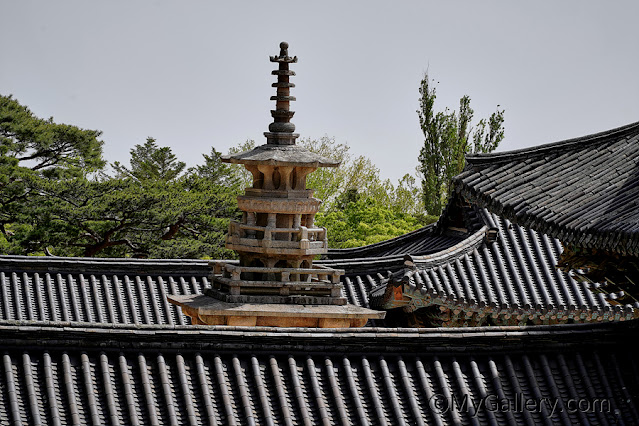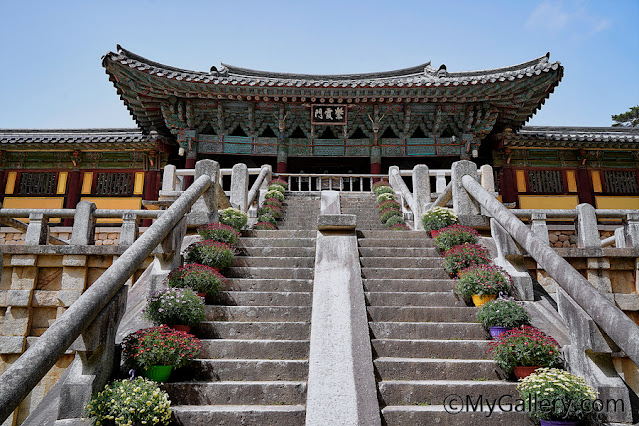Oh, the moonlit night of Silla As the lyrics of the song "The Bells of Bulguksa Temple Come to You!" reminds me of Bulguksa Temple immediately when I think of "Bulguksa" when I think of "Silla," and Bulguksa Temple is a very famous thousand-year temple. Bulguksa Temple is a representative place of traditional Korean temples, and it was a memorable school trip place for many people, and it was also known as a honeymoon destination.
Bulguksa Temple in Gyeongju is a very old temple historically. It was built by Kim Dae-sung in 751 during the Silla period and was completed in 774, so it was built for 23 years. Of course, in that era, there was no heavy equipment like today, so everything would have been built with manpower, and it took quite a long time to build it. However, when the Imjin War( Japanese invasions of Korea in 1592) broke out, many buildings were burned down. After that, only some temple buildings such as Geungnakjeon Hall, Beomyeongnu Pavilion, and Jahamun Gate were barely maintained, but much of them were restored during excavation investigations in 1969, and they became what they are now.
Representative buildings of Bulguksa Temple include Dabotap Pagoda built during the Unified Silla Period, a three-story stone pagoda called Seokgatap Pagoda, Cheongun Baegungyo Bridge to Jahamun Gate, and Yeonhwa Chilbogyo Bridge to Geungnakjeon Hall. If you look at the architecture of Bulguksa Temple, each one shows the height of architectural art. The delicate and elegant form of architecture is no less inferior than any other architecture in the world. Really, at that time, the Silla people were good at handling stones, and the architecture is considered great. So Bulguksa Temple was registered as a World Heritage Site in 1995.
About Bulguksa Temple
Bulguksa Temple is a historic Buddhist temple located on the slopes of Mount Toham in Gyeongju, South Korea. It is one of the most renowned temples in the country and holds great significance in Korean Buddhism and cultural heritage. Bulguksa Temple, along with the Seokguram Grotto, is collectively designated as a UNESCO World Heritage site.
Bulguksa Temple is a historic Buddhist temple located on the slopes of Mount Toham in Gyeongju, South Korea. It is one of the most renowned temples in the country and holds great significance in Korean Buddhism and cultural heritage. Bulguksa Temple, along with the Seokguram Grotto, is collectively designated as a UNESCO World Heritage site.
More detailed information on Bulguksa Temple
History: Bulguksa Temple was initially built in 528 AD during the Silla Dynasty, which was one of the Three Kingdoms of Korea. The temple was constructed under the patronage of the Silla ruler, King Beopheung, but it underwent several expansions and renovations over the centuries due to damage from wars and natural disasters.
Architecture: The temple complex showcases exceptional architectural brilliance and exquisite craftsmanship. The design follows the traditional principles of Korean Buddhist temple architecture. It consists of several halls, pagodas, and bridges, surrounded by beautiful gardens and wooded areas. The main buildings include Daeungjeon Hall (Hall of Great Enlightenment), Geungnakjeon Hall (Hall of Supreme Bliss), and Museoljeon Hall (Hall of No Words).
Daeungjeon Hall: Daeungjeon Hall is the main hall of Bulguksa Temple and houses important Buddhist relics. The hall is adorned with intricate wood carvings and decorative paintings, depicting various Buddhist figures and mythological creatures. The interior of the hall is spacious and houses three gilded statues representing the Buddha and his disciples.
Seokgatap and Dabotap Pagodas: Bulguksa Temple is famous for its two stone pagodas—Seokgatap and Dabotap. Seokgatap, also known as the Pagoda of Sakyamuni Buddha, is a three-story pagoda symbolizing the Buddha's teachings. Dabotap, meaning "Many Treasures," is a magnificent pagoda standing at 10.4 meters tall, known for its delicate balance and artistic beauty.
Seokguram Grotto: Although located a short distance away from the main temple complex, Seokguram Grotto is closely associated with Bulguksa Temple. It is an artificial grotto that houses a large granite statue of Buddha. The statue is considered a masterpiece of Buddhist art and is highly revered.
Cultural Significance: Bulguksa Temple is not only a religious site but also a significant cultural landmark in Korea. It represents the architectural and artistic achievements of the Silla Dynasty and reflects the strong influence of Buddhism in the country's history. The temple attracts numerous visitors and pilgrims who come to admire its beauty and seek spiritual solace.
Festivals and Events: Throughout the year, Bulguksa Temple hosts various religious ceremonies, cultural festivals, and events. These include lantern festivals, Lotus Lantern Festival, and traditional Buddhist rituals. These celebrations provide an opportunity for visitors to experience the rich heritage and vibrant cultural traditions of Korea.
Bulguksa Temple is a place of serenity and spiritual reflection, offering visitors a glimpse into Korea's ancient Buddhist legacy. Its harmonious blend of natural surroundings, magnificent architecture, and religious significance makes it a must-visit destination for those interested in Korean history and culture.
by MyGallery.com












.jpg)


Social Plugin